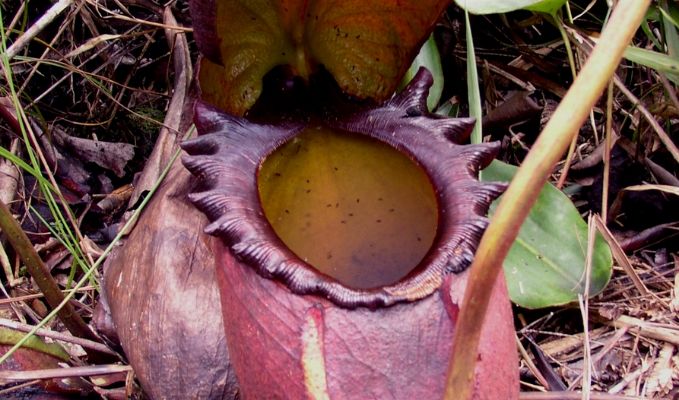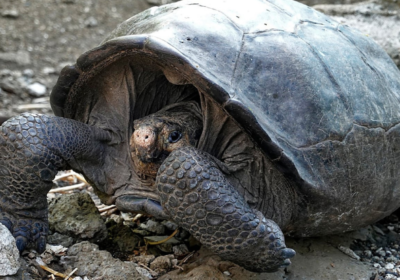What is the normal food chain on the Earth? Herbivorous animals eat plants. Larger animals eat smaller animals, and the cycle goes on. Carnivorous plants are the disobedient members of this chain. They don’t get eaten up by animals, and moreover, become predators of small animals. These plants usually feed on insects. They have turned carnivores for nutrient supply as most carnivorous plants grow in poor soil. Let us delve into some facts about carnivorous plants. We shall look at the best 7 of them.
Nepenthes Rajah

Pitcher plants are the most popular category of carnivorous plants. These plants have small pitcher-shaped parts to capture their prey. Pitcher plants are also called monkey cups. Nepenthes Rajah is popularly referred to as the king of pitcher plants. It also holds the title of being the largest carnivorous plant.
The jug-like traps of the plant are big enough to hold up to 3 liters of water. It can trap frogs, lizards and rats. Another unique feature of these plants is that they feed on poops! They attract mountain tree shrews with nectar, and in turn, collect their droppings in the pitcher. These droppings are rich in nitrogen which helps the plants to grow.
Facts About carnivorous plants with a death trap: Venus Flytrap

Venus flytrap is a carnivorous plant which sets a unique death trap for insects. It has trap which is made out of the terminal portion of leaves. These leaves have stiff and sensitive hairs protruding from their edges. When an insect touches these hairs, the leaves close around it. The insect is trapped inside and later, devoured by the plant.
Venus flytrap is common in the wetlands on the East Coast of the United States. It lives in soil which is poor in nutrients. So this insect-catching mechanism of the plant helps it to fulfil the nutritional requirements. The plant resorts to insects for its nitrogen feed.
Venus flytraps can supply some interesting facts about carnivorous plants. If you feed them with dead insects, they won’t accept! The leaves don’t close if you put a dead insect inside it. Only a moving action can trigger the closing of leaves.
Butterwort plants

Butterworts are carnivorous plants that trap insects with sticky glue. They are the flypapers built by nature. Due to this unique property, they have the name flypaper plants too. These plants have sticky glue-like secretion covering their leaves. When an insects sits on the leaves, it sticks to the glue.
Butterworts are common in the entire Northern Hemisphere. They grow in soil which is poor in nutrient value. This necessitates their carnivorous trait. Butterworts can be classified into two major categories, tropical and temperate. Butterworts growing in tropical regions do not undergo a winter dormancy whereas those living in temperate climate produce a winter-resting bud in winters.
Bladderwort plants

Bladderworts are a group of carnivorous plants which have a bladder-like traps to capture tiny organisms. Bladderwort has approximately 233 species in itself. Aquatic species of these plants thrive in freshwater whereas the terrestrial species grow in wet soil.
Bladderwort plants are unique as they do not have well-defined roots, leaves or stems. They have an efficient system of traps which traps the prey within a fraction of a second. Bladder trap is one of the most sophisticated structures in the plant kingdom.
Facts About carnivorous plants that fascinated Darwin: Sundew Plant

Sundew is the common name for the carnivorous plants that belongs to the Drosera category. It is a plant that caught the fancy of the famous biologist, Charles Darwin. The plant caught his fancy, and he wrote, “I care more about the Drosera plant than the origin of all the species in the world.”
Sundew plant derived its name due to the dew-like glue present on the edges of its leaves. These are the traps which help the plant to feed on insects. Small insects find these pretty plants very attractive; they come near the plant and stick to the glue. When they eventually die, the plant secretes enzymes to digest the nutrients from the insects.
Waterwheel Plant

Waterwheel plant is the common name for the carnivorous plant, Aldrovanda vesiculosa. This plant is the sole surviving species in the Aldrovanda genus of plants. It is an aquatic plant without roots. Waterwheel plants use traps similar to Venus flytraps.
The waterwheel plants capture all small aquatic creatures such as mosquito larvae, small fish and tadpoles. They prefer clean and shallow water for their sustenance. The waterwheel plant is an endangered species of plants.
California Pitcher plant

As the name suggests, the California pitcher plant is a carnivorous plant common in Northern California. It is also called the Cobra lily due to the shape of its leaves. The tubular and forked leaves of the plant resembles a striking cobra.
Colonies of California pitcher plants usually form near cold water mountain streams. The nectar present in the tongue-like part at the edge of the pitcher attracts insects. Cobra lily is an efficient insect catcher, as can be ascertained from the large number of insect remains found inside the pitcher.
These are some of the most amazing facts about carnivorous plants. Did you enjoy reading? Move to our Fascinating Facts section to find more.




